![[no title] by Georg Baselitz](/_next/image?url=https%3A%2F%2Fd2w8kbdekdi1gv.cloudfront.net%2FeyJidWNrZXQiOiAiYXJ0ZXJhLWltYWdlcy1idWNrZXQiLCAia2V5IjogImFydHdvcmtzLzQ5ZDYwNWMwLWFlOWItNDU5Yy04NDhhLTVkMGJkZjE3Mzk4MS80OWQ2MDVjMC1hZTliLTQ1OWMtODQ4YS01ZDBiZGYxNzM5ODFfZnVsbC5qcGciLCAiZWRpdHMiOiB7InJlc2l6ZSI6IHsid2lkdGgiOiAxOTIwLCAiaGVpZ2h0IjogMTkyMCwgImZpdCI6ICJpbnNpZGUifX19&w=2048&q=75)
Dimensions: image: 287 x 179 mm mount: 561 x 408 x 4 mm
Copyright: © Georg Baselitz | CC-BY-NC-ND 4.0 DEED, Photo: Tate
Curator: Here we have an untitled etching by Georg Baselitz, created in 1995. The dimensions of the image itself are roughly 28 by 18 centimeters. What strikes you about this work? Editor: It feels like a frantic dream. Lines everywhere, a figure...maybe? It's disorienting but also weirdly compelling. Like a visual scream. Curator: Baselitz is, of course, known for his inversion. The etching process itself – the biting of the plate, the inking, the pressure – all contribute to this unsettling effect. The economy of line and the focus on the materiality of the printmaking process certainly challenge any easy reading. Editor: That's true; it makes you think about the physical act of making it. But the image itself... it's like a deconstructed body, or maybe a soul trying to escape. Curator: Perhaps. It's a powerful example of how abstraction can still convey very human emotions. Editor: Exactly. It's messy, raw, and utterly captivating. Curator: Indeed. This piece really showcases how form and process can work together to evoke such intense feelings. Editor: I agree, and it makes me want to see more of his work.
Comments
Join the conversation
Join millions of artists and users on Artera today and experience the ultimate creative platform.
tate 7 months ago
⋮
Baselitz’s vigorous and expressive style, influenced by the drawing and paintings of the mentally ill, often represents the body as a site of anxiety. This series of prints show a female figure crouching and twisted. The body is fragmented: in some works, the head is cropped, while others feature only isolated limbs. The hatched and scored quality adds to the sense of raw spontaneity and even violence. Many of the prints include flowers and vegetation which, with the use of greens and browns, suggest wild nature and fertility. Gallery label, July 2015













